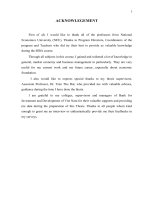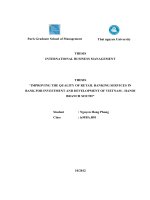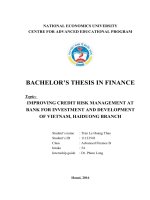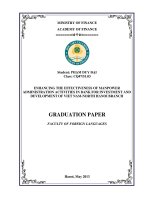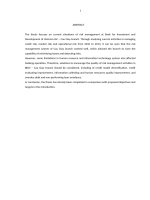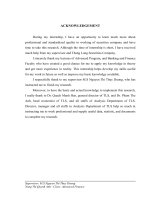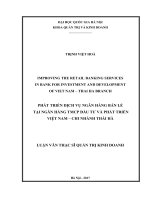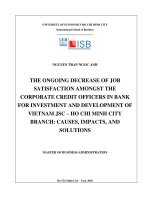Solutions to improve the efficiency of risk management in bank for investment and development of vietnam JSC – cau giay branch
Bạn đang xem bản rút gọn của tài liệu. Xem và tải ngay bản đầy đủ của tài liệu tại đây (1.3 MB, 46 trang )
i
ABSTRACT
The thesis focuses on current situations of risk management at Bank for Investment and
Development of Vietnam JSC – Cau Giay branch. Through analyzing current activities in managing
credit risk, market risk and operational risk from 2010 to 2013, it can be seen that the risk
management system of Cau Giay branch worked well, which allowed the branch to have the
capability of minimizing losses and detecting risks.
However, some limitations in human resource and information technology system also affected
banking operation. Therefore, solutions to encourage the quality of risk management activities in
BIDV – Cau Giay branch should be considered, including of credit model diversification, credit
evaluating improvement, information collecting and human resources quality improvement, and
overdue debt and non-performing loan avoidance.
In conclusion, the thesis has already been completed in comparison with proposed objectives and
targets in the introduction.
ii
TABLE OF CONTENT
ABSTRACT................................................................................................................................................. I
TABLE OF CONTENT.................................................................................................................................. II
LIST OF TABLES AND CHARTS................................................................................................................... IV
LIST OF ABBREVIATIONS.......................................................................................................................... IV
INTRODUCTION........................................................................................................................................ 1
1. RATIONALE OF THE STUDY
2. AIMS OF THE STUDY
3. METHODS OF THE STUDY
4. SCOPE AND SUBJECT OF THE STUDY
5. STRUCTURE OF THE STUDY
1
1
2
2
2
CHAPTER I................................................................................................................................................ 3
LITERATURE REVIEW................................................................................................................................. 3
1.1. RISKS
3
1.1.1. Definitions.........................................................................................................................................3
1.1.2. The categories of risks......................................................................................................................3
1.1.2.1. Credit risk.......................................................................................................................................4
1.1.2.2. Market risk.....................................................................................................................................5
1.1.2.3. Operational risk.............................................................................................................................6
1.2. RISK MANAGEMENT
7
1.2.1. Definitions.........................................................................................................................................7
1.2.2. Risk measurement............................................................................................................................8
1.2.2.1. Credit risk measurement...............................................................................................................8
1.2.2.2. Market risk measurement...........................................................................................................10
1.2.2.3. Operational risk measurement....................................................................................................11
1.3. RISK MANAGEMENT PROCESSES
12
1.3.1. Components of risk management process.....................................................................................12
1.3.2. Strategies for risk management.....................................................................................................13
1.3.3. Roles in the risk management process...........................................................................................14
CHAPTER II............................................................................................................................................. 16
THE REALITY OF RISK MANAGEMENT IN BIDV – CAU GIAY BRANCH.........................................................16
2.1. OVERVIEW OF BIDV
16
2.1.1. General introduction about BIDV...................................................................................................16
2.1.2. Development orientation................................................................................................................17
2.2. OVERVIEW OF BIDV – CAU GIAY BRANCH
18
2.2.1. Organizational structure.................................................................................................................19
2.3. CURRENT SITUATION OF RISK MANAGEMENT IN BIDV – CAU GIAY BRANCH
19
2.3.1. Current activities.............................................................................................................................19
2.3.1.1. Business performance.................................................................................................................19
2.3.1.2. Fund mobilization........................................................................................................................21
2.3.2. Current situation of credit risks at Cau Giay branch......................................................................22
2.3.2.1. Credit model................................................................................................................................22
iii
2.3.2.2. Overdue debt and NPL.................................................................................................................24
2.3.2.3. Provision plan..............................................................................................................................25
2.3.2.4. Income from credit activities.......................................................................................................26
2.3.3. Current situation of market risk management at Cau Giay branch...............................................27
2.3.4. Current situation of operational risk management at Cau Giay branch........................................27
2.3.5. The assessment of the risk management situation at BIDV – Cau Giay Branch during the 2010 –
2013 period...............................................................................................................................................29
2.5.3.3. Causes..........................................................................................................................................30
2.4. STRENGTHS AND WEAKNESSES OF RISK MANAGEMENT AT CAU GIAY BRANCH
30
2.4.1. Strengths........................................................................................................................................30
2.4.2. Weaknesses....................................................................................................................................31
2.4.3. Opportunities..................................................................................................................................31
2.4.4. Challenges......................................................................................................................................32
CHAPTER III............................................................................................................................................ 33
SUGGESTIONS TO IMPROVE THE EFFICIENCY OF RISK MANAGEMENTIN BIDV – CAU GIAY BRANCH..........33
3.1. THE DEVELOPMENT ORIENTATION OF BIDV
3.2. SUGGESTIONS TO IMPROVE THE EFFICIENCY OF RISK MANAGEMENT IN BIDV – CAU GIAY BRANCH
33
34
3.2.1. Credit model diversification............................................................................................................34
3.2.2. Credit evaluating improvement......................................................................................................34
3.2.3. Information collecting improvement..............................................................................................35
3.2.5. Human resources quality improvement.........................................................................................36
3.3. RECOMMENDATIONS
37
3.3.1. Recommendations to the Government...........................................................................................37
3.3.1. To State bank of Vietnam...............................................................................................................38
3.3.2. To BIDV............................................................................................................................................38
CONCLUSION.......................................................................................................................................... 40
REFERENCES........................................................................................................................................... 41
iv
LIST OF TABLES AND CHARTS
TABLES
Table 1: NPL rate of BIDV against other banks....................................................................................32
Table 2: Overdue debt and NPL proportion over 2011-2013 period of BIDV – Cau Giay Branch......33
Table 3: Provision plan over 2010-2013 period..................................................................................34
Table 4: Income from credit activities over 2010 – 2013 period........................................................35
FIGURES & CHARTS
Figure 1: Three main types of risks......................................................................................................05
Figure 2: Sources of Operational Risk..................................................................................................09
Figure 3: Making Consistent Risk Management Decisions.................................................................18
Figure 4: Strategies for risk management...........................................................................................19
Figure 5: Roles in the Risk Management Process...............................................................................21
Figure 6: The organizational structure of Cau Giay Branch................................................................26
Chart 1: Total asset and Profit before tax of Cau Giay branch (2010-2013).......................................27
Chart 2: Fund mobilization situation of Cau Giay branch (2010-2013)..............................................29
Chart 3: Outstanding loan on term over 2010-2013 period...............................................................30
Chart 4: Credit model in terms of borrower over 2010-2013 period.................................................31
LIST OF ABBREVIATIONS
Abbreviations
BIDV
Meanings
Joint Stock Commercial Bank for Investment and Development of
v
BIS
BOD
CIC
EVA
IT
NPLs
P&L
VaR
VCB
VND
Vietnam
The Bank of International Settlement
Board of Directors
Credit Information Centre
Economic Value Added
Information Technology
Non - performing loans
Profit and Loss
Value at Risk
Vietcombank ( Bank for Foreign Trade of Vietnam)
Vietnamese Dong
INTRODUCTION
1. Rationale of the study
Thanks to new opportunities created by international economic integration, Vietnam economy has
achieved noticeable achievements recently. It also has led to significant changes in the overall
economy in general and particularly in Vietnam’s banking sector, especially in commercial banks.
Commercial banks in Vietnam have grown in both quality and quantity over the last few years. It is
considered as a bridge which connects several sectors in the economy, a currency and credit
center distributing to the sustainable development of the country.
However, in the changing business environment and sharp competitions, those banks have to face
with several risks from both external and internal sources. Any problems arising from the activities
of banks can immediately and directly affect their clients and indirectly other involved subjects.
Moreover, the weakness of banking operations, the incompleteness in the policy system and the
likes have caused serious consequences such as increasing non-performing debts, losses, or fraud.
According to the Banking Magazine of the State Bank of Vietnam (2012), there was an upward
trends in non-performing debt rate, from 3.07% in December 2011 to 4.22% in April 2012. As the
result, in order to prevent these consequences, creating an efficiency risk management system
must be the top priority of commercial banks. Furthermore, any banks that can manage risks well
will survive and develop in the market in the long run. Therefore, the study for solution to improve
risk management is a frequent and urgent issue of banking industry in Vietnam.
Risk management is also important to Cau Giay branch of Bank for Investment and Development
of Vietnam JSC, one of the most efficiently operating branches. During the past years, the branch
has achieved certain successes in identification and managing risks; however, the risk
management polices has been incomplete and imperfect, resulting in high possibility of losses.
Therefore, the branch has made an attempt to improve efficiency further.
Because of above reasons, the topic: “Solutions to improve the efficiency of risk management in
Bank for Investment and Development of Vietnam JSC – Cau Giay branch” was chosen as the
issues for this study.
2. Aims of the study
The general aim of this thesis was to study risk management at Cau Giay branch of BIDV and
through that, some suggestions and implications was proposed to enhance the efficiency of risk
management at Cau Giay branch, BIDV.
The thesis answered main questions:
Firstly, what are the current situations of managing risks at Cau Giay branch?
Secondly, which implications BIDV - Cau Giay branch should apply to manage risks?
3. Methods of the study
In order to achieve the aim of the study, there was a combination between comparison and
analysis methods in order to find out the strengths, shortcomings, opportunities as well as
recommend some solutions for improving the efficiency of risk management in BIDV – Cau Giay
branch.
Based on banks’ annual reports, financial statements, websites, newspapers, government
publication, finance journals, banking statistics, books, surveys and industry reports, the figure of
business performance and credit activities such as total assets, profit before tax, fund
mobilization, outstanding loan, and non – performing loans (NPL) during 2010 – 2013 period were
compared and analyzed to notice the trend and the quality of credit risk management. There was
also a comparison between NPL of BIDV and that of other commercial banks, which illustrated the
competitiveness of BIDV in the market.
In addition, the analyses in market and operational risk management were used to show the
capacity of Cau Giay branch when handling risks.
4. Scope and subject of the study
My research mainly concentrates on risk management at BIDV, Cau Giay branch under the
economic perspective in terms of space and in period 2010-2013 in term of time.
5. Structure of the study
Apart from the introduction, conclusion, references and documents attached, the main content is
divided into three chapters as follows:
Chapter 1:“Literature review” gives brief introduction to the risks by compiling the different ideas
and influences of experts about risks, risk management in banking, types of risks, risk
measurements and risk management process.
Chapter 2:“The reality of risk management in BIDV – Cau Giay Branch” focuses on the basis of
analyzing the current situations and evaluating the management of risks over the years.
Chapter 3:“Suggestions to improve the efficiency of risk management in BIDV – Cau Giay branch”
brings some suggestions to minimize risks and thus increases risk management quality.
CHAPTER I
LITERATURE REVIEW
1.1.
Risks
1.1.1.
Definitions
“Risk” has long been studied, especially in recent years. It is one of those concepts which do not
have a universal definition. Each author has a different approach to define risk.
Gallati, R (2003) defines risk as a condition in which there exists an exposure to adversity, or a
condition in which there exists a possibility of deviation from a desired outcome that is expected
or hoped for. Another definition of risk was provided by Bessis, J (2002) in which risk was defined
as the probability or threat of quantifiable damage, injury, liability, loss, or any other negative
occurrence that is caused by external or internal vulnerabilities, and that may be avoided through
preemptive action.
Despite some different factors, these definitions all agree that risk is the chance that in some
unfavorable and unexpected events will occur.
In the banking industry, “Banking risks are defined as adverse impacts on bank’s profitability
arising from several distinct sources of uncertainty”. (Bessis (2002))
For the purposes of this thesis, risk is defined as the volatility of a corporation’s market value
(Kupper, E (1999)). Therefore, all decisions may impact on a change in market value.
1.1.2.
The categories of risks
There are numerous methods to classify types of risks. However, in practices, banks tend to focus
their energies and resources on understanding and managing the key drives that determine
financial loss. In that sense, they focus on three main types of risks: credit risk, market risk and
operational risk.
Figure 1 provides a bird’s eye view on three main types of risk and its components.
Figure 1: Three main types of risks
RISKS
CREDIT RISK
OPERATIONAL
RISK
MARKET
RISK
•Risk grading
• Single name
• Single transaction
• Industry/ Sector
• Country/ Region
• Product
• Event risk
• Payments/Settlement
• Trading risk
• Balance sheet risk
risk
• Technology/Systems
exposure
• Fraud/Compliance risk
• Natural disaster
• Change management
• Tenor
• Credit skills and
training
(Source: Kupper, E (1999))
1.1.2.1. Credit risk
Definitions
Credit risk is one of the main risks of commercial banks that will affect the banks’ possibility of
sustainable operation. Banks assume credit risk when they act as intermediaries of funds and
credit risk management lies at the heart of commercial banking.
In a 1996 report, the Bank of International Settlement (BIS) defined credit risk as the risk that a
counterparty will not settle an obligation for full value, either when due or at any time thereafter.
After that, Viney, C (2009, p.728) found that credit risk was the possibility that a borrower or a
debtor will not meet future financial obligation to pay interest installments or to repay debt
principal when due.
On the other hand, according to Decision No.493/2005/QD-NHNN dated 22 April, 2005 by
Vietnam government, credit risk is seen as the potential that a bank borrower or counterparty will
default on any type of debt by failing to make payments when it is obligated to do.
In short, these definitions share the same idea that credit risk is the potential financial loss
resulting from the failure of customers to honour fully the terms of a loan or contract. This
definition is being expanded to include the risk of loss in portfolio value as a result of migration
from a higher risk grade to a lower one.
Sources of credit risks
Credit risk arises from a number of causes as follow:
• From the banks themselves: Due to loose credit policies and procedures, ineffective risk
management, inappropriate customer credit’s need, insufficient professional qualification of credit
staff…
• From the customers: Due to limited governance capacity of customers, capital incapable
customers who are not able to carry out planned business, cheating customers...
• From business environment: Due to reasons of force majeure (natural disasters, plague...),
changing in macroeconomic policies and legal environment, asymmetric information...
In the current changing business conditions, credit risk management becomes more complicated.
That fact requires each bank must constantly enhance risk management capability, especially
credit risk.
Types of credit risks
There are two main types of credit risk, credit default risk and credit spread risk.
According to Winkler, G. (2008, p.12), default risk is the risk of loss arising from a debtor being
unlikely to pay its loan obligations in full or from the debtor missing payment for more than 90
days on any credit obligations. Default risk may impact all credit transactions including loans,
securities and derivatives.
The credit spread is the excess premium over the government or risk-free rate required by the
market for taking on a certain assumed credit exposure.
It is important to notice that the higher the credit rating, the smaller the credit spread. Thus, the
credit spread risk is the risk of financial loss resulting from changes in the level of credit spreads
used in the marking-to-market of a fixed income product. Changes in observed credit spreads
affect the value of the portfolio and can lead to losses for traders or underperformance for
portfolio managers.
1.1.2.2. Market risk
Definitions
Bank for International Settlement defines market risk as “the risk of losses in on- and off-balancesheet positions arising from movements in market prices.” In this respect, the main factors
contributing to market risk are equity, interest rate, foreign exchange, and commodity risk. The
total market risk is the aggregation of all risk factors (Sironi, Resti, 2007; Dowd, 2002)
Another definition is that market risk is the risk of adverse deviations of the mark-to-market value
of trading portfolio, due to market changes, during the period required to liquidate the
transaction.
Market risk is also defined as the risk to earnings arising from changes in interest rates or
exchange rates, or from fluctuations in bond, equity or commodity prices. Banks are subject to
market risk in both the management of their balance sheets and in their trading operations.
Sources of market risks
Banks are exposed to market risk via their trading activities and their balance sheets.
The risks caused through trading activities are easier to detect by using Value at Risk method (VaR)
than other risks.
The other component of market risk is the interest rate risk on banks’ balance sheets.
This risk results from timing differences in the repricing of assets and liabilities, and the
investment of capital. The capital allocated to this type of risk is intended to cover the potential
loss in earnings resulting from a change in interest rates. Essentially this capital is an estimate of
the cost of closing out the mismatches following an extreme event.
1.1.2.3. Operational risk
Definitions
According to global risk management survey of Deloitte, 8th edition, roughly 60% of institutions
rated their operational risk methodologies as well developed for both risk assessments and for
their internal loss event database.
Operational risk was for the first time treated as a self-contained regulatory issue in the
“Operational Risk Management” document published by the Basel Committee on Banking
Supervision in 1998.
The New Basel Accord defines operational risk as “The risk of direct or indirect loss resulting from
inadequate or failed internal processes, people and systems or from external events.”
The potential financial loss is seen as a result of a breakdown in day-to-day operational processes.
Operational risk can arise from failure in complying with policies, laws and regulations, from fraud
or forgery, or from a breakdown in the availability or integrity of services, systems or information.
Types of operational risk
According to its measurement and management, operational risk can be divided into:
• Event risk: the risk in which losses of the bank are caused by rare events such as a major systems
failure, process and control failures (e.g., errors and omissions), fraud, legal risk, and external
disruption (e.g., fire or other catastrophes).
• Business risk: the risk that the bank will experience losses through unexpected changes in either
(future) revenues (affected by volume and price) or (fixed) costs that are not due to credit or
market risk, but rather driven by fundamental (and unexpected) changes in the bank’s competitive
environment (e.g., price wars, changes in regulation, etc.).
Sources of operational risks
A quick scan through Figure 2 reveals that the most worrying events are those that are very rare,
yet could have a devastating impact on a business.
Figure 2: Sources of Operational Risk
Operational Risk
•Execution error
Business/Event Risk
•Product complexity
• Booking error
Transaction
•Settlement error
Regulation
risk
•Commodity delivery risk
risk
•Documentation/
contract
• Breaching capital
requirements
• Regulatory changes
risk
• Exceeding limits
• Rogue trading
Operational
• Fraud
• Natural disasters
control
• Money laundering
Disaster
•War
risk
• Security risk
risk
•Collapse/suspension
• Key personnel risk
of markets
• Processing risk
•Programming error
• Currency convertibility risk
•Model/methodology error
• Shift in credit rating
•Mark-to-market error
• Reputation risk
Systems
•Management information
• Taxation risk
risk
• IT systems failure
• Legal risk
•Telecommunications failure
•Contingency planning
(Source: PricewaterhouseCoopers (1996))
In conclusion, credit risk is the first of all risks in terms of importance. According to one estimate,
credit risk takes about 70% and 30% remaining is shared between the other primary risks, namely
Market risk and Operational risk.
1.2. Risk management
1.2.1.
Definitions
The concept of risk management was first introduced into business strategy in 1916 by Henry
Fayol. But it only became formalized after Russell Gallagher (1956) published “Risk Management:
A New Phase of Cost Control” in the Harvard Business Review and argued that “the professional
insurance manager should be a risk manager”.
According to Schroeck (2002), risk management can be regarded as an active, strategic, and
integrated process that encompasses both the measurement and the mitigation of risk, with the
ultimate goal of maximizing the value of a bank, while minimizing the risk of bankruptcy.
More specifically, risk management in banking designates the entire set of risk management
processes and models allowing banks to implement risk-based policies and practices. They cover
all techniques and management tools required for measuring, monitoring and controlling risks
(Bessis, J (2002)). Therefore, the goal of risk management should be to identify any uneconomic
risk taking, in other words, to ensure that any risk-management activity is consistent with value
maximization. The ultimate objective should not be to minimize, or worse, to avoid all risks, but it
should be to find the optimal balance between risks taken and expected returns, optimizing the
risk-reward trade-off, concentrating on the competitive advantage of the company.
Managing risks includes:
• Risk identification: Identifying factors that affect a potential loss in transactions of a bank, its
activities, processes, and systems
• Risk measurement: Calculating or estimating the value of an identified risk using a chosen
method or procedure.
• Risk monitoring: Comparing measured risk values with values set by a bank, particularly in form
of limits and continual control of meeting the set limits.
• Risk minimizing: Entering into transactions of a bank or performing its activities serving to
mitigate exposure to risk.
1.2.2.
Risk measurement
1.2.2.1. Credit risk measurement
Criteria of measuring credit risk
Criteria of measuring credit risks include overdue debts, ratio of customers having bad debts, and
non-performing loans (NPL).
• Overdue debts
Gross overdue debts
Overdue debts rate =
* 100
Gross debts
Low overdue debts rate proves that the credit quality is high. When absolute numeric value of the
overdue debts goes down, if the gross debts increase then overdue debts rate has not reflected
the nature of credit.
•
Ratio of customers having bad debts
Number of customers having
overdue debts
Ratio of customers =
having bad debts
* 100
Gross numbers of customers
having credit relationship
The more customers having overdue debts, the higher credit risk that banks have to face. This
ratio also shows the quality of borrower’s risk evaluation of bank.
•
Ratio of NPL
Amount of NPL
Ratio of NPL
=
* 100
Total outstanding loans
A higher than expected NPL rate may cause have serious consequences, affecting the banks, the
customers, and sometimes in extremely bad cases, the economy. NPL rate also reflects the
reputation of banks. If the bank works well, the NPL rate must be low.
Sources of losses on a credit portfolio
There are three factors that drive expected and unexpected losses on a credit portfolio:
• Customer default risk – determined by the risk-grade profile of the portfolio, the tenor of the
exposures and the degree of exposure to country risk. Typically, the default rates are calibrated to
those of Moody’s Investors Service and Standard & Poor’s Ratings Service.
In order to measure risks caused by customers, banks use credit scoring technique. In its early
meaning, credit scores were assigned to each customer to indicate its risk level. A good credit
scoring model has to be highly discriminative: high scores reflect almost no risk and low scores
correspond to very high risk. The more highly discriminative the scoring system is, the more
borrower’s risks are detected. In the past, credit scoring focused on measuring the risk that a
customer would not fulfill his/her financial obligations and run into payment debts. More recently,
credit scoring evolved to loss and exposure risk as well.
• Exposure – the amount that is likely to be outstanding at the time of default. This includes
current drawn amounts as well as an allowance for contingent liabilities and undrawn lines
• Loss given default – determined by the level of security cover, the effectiveness of the work-out
process and the credit cycle.
Although progress has been made in the area of credit risk modeling, the industry as a whole is
still struggling to find a consistent measure of credit risk. To overcome the lack of consistency,
several industry initiatives are underway. There are several credit rating agencies are taking a more
active role in the credit oversight process in order to help banks measures credit risks.
1.2.2.2. Market risk measurement
Value at Risk (VaR)
In order to manage market risks, major trading institutions have developed large scale risk
measurement models. While approaches may differ, most models measure and aggregate market
risks in current positions at a highly detailed level. The models employ a standard risk metric,
Value-at-Risk (VaR), which is a lower tail percentile for the distribution of profit and loss (P&L).
VaR measures the maximum loss in portfolio value over a one-day holding period with 97.5 per
cent confidence.
In that sense, denoting the portfolio’s P&L by rt, so that each day t the bank forecasts rt+1. The
VaR forecast is the quantity r such that pr(rt+1 < r) = α over the next trading day. Here α = 0.01 so
that the model predicts a lower bound on losses not to be exceeded with 99% confidence.
For example, if an activity has a VaR of $10 million, it can be expected that in 29 out of 30 days,
losses will be less than $10 million. Conversely, in 1 out of 30 days, losses can be expected to
exceed $10 million.
Although VaR has been widely used, it also widely criticized tool to assess risks. The reason is that
VaR does not capture the very low-probability events that are of real concern. Moreover, it is
based on assumptions that may not be true in the real world.
Therefore, risk managers have to notice 2 particular assumptions:
The first is the shape of the loss distribution under VaR, changes in asset prices are commonly
assumed to follow a normal distribution. While this may be reasonable in some cases, it is not true
in general. Moreover, in extreme circumstances the distribution of asset prices can change shape
quite significantly.
The second is the data period used to evaluate risks. It is easy to believe that longer data series
create more reliable results when estimating price volatility and correlations, since they involve a
greater number of data points. However, when predicting events that may occur over in shortterm such as a week, circumstances that existed a year ago are usually irrelevant. By contrast, the
events in the previous week could be very important and should be weighted more heavily in the
forecasts of future price volatility.
To overcome the shortcomings of the modeling process, the daily VaR estimation are maintained
by the banks for the purpose of “stress testing” or “back-testing” and are required by regulation to
be calculated with the same risk model used for internal measurement of trading risk.
In terms of stress-testing, it is to see what happens under exceptional conditions. A common way
to stress a portfolio is using extreme conditions that prevailed historically over a long period. The
practical way of identifying such worst – case scenarios is to examine the portfolio structure, to
identify its main exposures and their risk drivers, and to try several shocks on various parameters
driving the risk of the major exposures.
In terms of back – testing, it is to ensure that models capture the actual deviations of the
portfolios. Back testing implies using the model with past data to check whether the modeled
deviations of values are in line or not with the historical deviations of values.
1.2.2.3. Operational risk measurement
Management of operational risk is not a new practice. It has always been important for banks to
try to prevent fraud, maintain the integrity of internal controls, reduce errors in transaction
processing, and so on in order to preserve the best quality services for their customers.
However, what is relatively new is the view of operational risk management as a comprehensive
practice comparable to the management of credit and market risk in principle.
In the past, banks relied almost exclusively upon internal control mechanisms within business
lines, supplemented by the audit function, to manage operational risk. While these remain
important, recently there has been an emergence of specific structures and processes aimed at
managing operational risk because of greater dependence on technology and centralized
operations which means that banks are becoming increasingly exposed to operational risk.
Some recent trends are:
• Banks are expanding their use of the Internet to service customers and perform basic functions
• Globalization is creating complex linkages between institutions and countries
• Part of the risk has been outsourced to third parties and so cannot be directly controlled
• Rules and regulations are expanding in an increasingly litigious society.
Financial institutions face significant challenges in implementing a program to monitor the
management of operational risk at the business unit. In addition to periodically testing and
monitoring business unit management of operational risk, risk management needs to embed
quality assurance and quality control procedures into the testing process so that it can
demonstrate its effectiveness.
Banks may choose different analytical or judgmental techniques to arrive at an overall operational
risk level for the firm. When measuring operational risk, it is required to estimate both the
probability of an operational loss event occurring and the potential size of the loss. The risk factors
are generally quantitative but may be qualitative and subjective assessments translated into
scores (such as an audit assessment) (Moosa, 2007). The set of risk factors often used includes
variables that measure risk in each business unit, such as grades from qualitative assessments
including internal audit ratings; generic operational data such as volume, turnover, and
complexity; and data on quality of operations such as error rate or measures of business riskiness
such as revenue volatility.
One of ways to increase the focus on operational risk is to allocate it to its natural owners. In most
cases, these are the managers of the businesses and support areas who have ultimate
responsibility for the continued operation of the organization. If the businesses rely on services
from central areas such as information technology, they must insist on service-level agreements
that specify the amount of back-up protection and associated costs. To avoid each business
focusing on short-term costs, the service units need to define minimum standards that must be
complied with. Although it is accepted that, in many cases, capital alone is insufficient to protect
the business, it is nevertheless important to make the level of risk as visible as possible for
performance management purposes.
One of the main constraints to developing capital allocation rules for operational risk is the
information base available to measure that risk in any meaningful way. Some banks have
attempted to overcome this constraint by creating a reference to other companies or industries
that do not assume any credit or market risk, and therefore derive their entire earnings volatility
from general business risk. By expressing the findings in known measures, such as operating
expenses, the results of these companies can be made comparable with those of the bank.
Another approach is to draw on the loss experience of a range of different industries, including the
insurance industry. While this approach could provide a larger inventory of events, many of the
relevant events, such as technology-driven losses, may not be published.
1.3.
1.3.1.
Risk management processes
Components of risk management process
There are four components to the management process:
• Define the desired shape and risk profile of the institution, covering the mix of businesses and
geographies
• Manage the risk profile at the business level, recognizing that risk management challenges and
responses can vary considerably between businesses
• Establish a management information system (MIS) that monitors performance and is tailored to
the requirements of each business
• Implement a performance management system that provides clear incentives to eliminate
unacceptable and unprofitable risks
These components are shown in figure 3.
Figure 3: Making Consistent Risk Management Decisions
• Define strategic and
non-strategic activities
Take decision
(Source: Elmer •Funke
•Kupper,
Align targets
risk and risk
•1999)
Alignand
targets
appetiteappetite
1.3.2. Strategies for risk
Risk culture
Risk culture
• Communicate
sive action
objectives
• Maintain core
competency
management
• Develop a
track record
In a bank, there are various ways to conduct risk management.
• Allocate responsibility
Figure 4 provides an overview of the options that banks have when approaching
• Captureain warehouse
• Ensure
independent
risk. The bank can decide to eliminate certain risks that are not consistent with
its desired
financial
• Conduct
stress
testing
oversight
eristic or, as often encountered in practice, the risks are not essential to the financial asset
• Provide flexible
• Take a portfolio
created. In order to eliminate specific risks the bank can use as a strategy portfolio
diversification
reporting
approach
or, in addition to this, can decide to buy insurance in the form of options or actuarial insurance, for
example, for event risks. The banks can create certain business policies, such as process control,
due diligence procedures, in order to reduce the chances of certain losses and even eliminate
certain risks.
Figure 4: Strategies for risk management
Hedge/ Sell
Eliminate/ Avoid
Diversify
Transfer
Insure
Absorb/ Manage
Set policy
(Source: Schroeck, 2002)
Hold capital
If the bank does not want to avoid some risk, it can decide to transfer it to other market
participants. The decision to transfer the risk to other market participants is made on the basis of
whether or not the bank has a competitive advantage in a specific segment and whether or not it
can achieve the fair market value for it.
The alternative to transferring risks is to keep the risks, to absorb (manage) them. Some risks must
or should be absorbed at the bank level, because they are to complex, or cannot be traded or
hedged easily or they are a business necessity.
Some risks play a central role in the bank’s business purpose and should therefore not be
eliminated or transferred.
The instruments that banks can use in order to manage the risks can be:
• Diversification is a technique that mixes a wide variety of investments within a portfolio. It is the
spreading out of investments to reduce risks. Diversification, typically, reduces the frequency of
both worst-case and best-case outcomes, which generally reduces the bank’s probability of failure.
• Hedge is a position established in one market in an attempt to offset exposure to price
fluctuations in some opposite position in another market with the goal of minimizing one’s
exposure to unwanted risk. There are many specific financial vehicles to accomplish this, including
insurance policies, forward contracts, swaps, options, many types of over-the-counter and
derivative products, and perhaps most popularly, futures contracts.
• Internal insurance: The bank is supposed to have superior risk pooling skills for some risks, that
is, it is cheaper for the bank to hold a pool of risks internally than to buy external insurance.
• Holding capital: For all other risks that cannot be diversified away or insured internally and
which the bank decides to absorb, it has to make sure that it holds a sufficient amount of capital in
order to ensure that its probability of default is kept at a sufficiently low level.
1.3.3.
Roles in the risk management process
The first stage of the risk management process is to define the risk appetite of the institution. In
deciding the shape and risk profile of the bank, the challenge is to differentiate clearly between
activities that are of strategic importance and those that are not.
Figure 5 lists some of the responsibilities of management as part of the ‘top-down’ approach to
managing risk.
Figure 5: Roles in the Risk Management Process
Emphasis on
• Define risk appetite
risk
and balance between
appetite and
businesses
policy
• Allocate resources and
capital
• Optimize the portfolio;
pick 'winners'
•
Maintain
a
well-
diversified portfolio
• Develop strategies to
optimize EVA
•
Design
delivery
systems
Emphasis on
risk
and
• Structure transactions
reward
•
trade-off
customer level
•
Optimize
Exit
assets
(Source: Elmer Funke Kupper, 1999)
EVA
at
subperforming
CHAPTER II
THE REALITY OF RISK MANAGEMENT IN BIDV – CAU GIAY BRANCH
2.1. Overview of BIDV
2.1.1.
General introduction about BIDV
BIDV is one of the three biggest banks in Vietnam with average total asset growth rate of 16.6%,
average funding and credit growth of 16.3% and 17.3% for years in a row. NPL ratio has been
restricted below 3%.
History
BIDV, the oldest Commercial Bank in Vietnam, was founded on 26th April 1957 under the name
Bank for Construction of Vietnam. History of construction and development of BIDV is a difficult
and trial but very proud path associating with historic period against invaders and country
construction of Vietnam people.
• From 1981 to 1989: It existed under the name Bank for Investment and Construction of Vietnam
• From 1990 to 27/04/2012: It existed under the name Bank for Investment and Development of
Vietnam (BIDV)
• From 27/04/2012 to now: It existed under the name Joint Stock Commercial Bank for Investment
and Development of Vietnam (BIDV)
• On 24 January, 2014: It was officially listed on Ho Chi Minh Stock Exchange
Along with country development, Joint Stock Commercial Bank for Investment and Development
of Vietnam contributed to postwar economic rehabilitation and implementation of the first fiveyear plan (1957-1965). In any circumstances, BIDV personnel always accomplish their mission- to
be a solider of the Party on monetary financial front and investment and development of country.
Acknowledge the contribution of BIDV through the periods, the Party and the Socialist Republic of
Vietnam have given to BIDV a lot of noble titles and rewards including First-Rate Independence
Medal and Third-Rate Independence Medal; First-Rate, Third- Rate Labor Medal, recognize as hero
of Labor in renovation period, Ho Chi Minh Medal, etc.
Fields of operation
BIDV operates in several fields, namely bank, insurance, stock and financial investments.
• Bank: BIDV functions as a leading experienced bank of finance services, brokerage, loan
syndication and advisory, modern, convenient banking products.
• Insurance: BIDV provides products for non-life insurance designed to match the overall package
to customers of BIDV.
• Stock: BIDV provides a wide range of brokerage services, investment and investment consultant
with the ability of quickly developing a system of agents to receive orders nationwide.
• Financial investments: BIDV includes financial leasing, security trading and capital contribution
with the aim at establishing investment companies to the project. Especially, it plays a leading role
in coordinating key projects of the country such as company Aviation stock leasing (VALC)
development company highway (BEDC), Investment, Long Thanh International Airport and so on.
2.1.2.
Development orientation
Mission
BIDV commits to provide the best modern banking-finance services to customers; bring the best
value to shareholders, create a professional and prominent working environment for employees
and pioneer in community development activities.
Vision
To become the most qualified, efficient and reputable Banking – Finance Group in Vietnam, the
core value of the bank is “Customer Orientation – Renovation and development – Creation and
Professionalism – Social Responsibility – Quality and Reliability.”
At the same time, service and product value orientation are:
Firstly, becoming the leader in making a comprehensive product solution to differentiate BIDV’s
with other conventional banking products provided by other banks to attract customers.
Secondly, providing best solutions to different targeted retail and corporate customer segments.
Thirdly, providing solutions for customers’ problems arose in their business such as risk prevention
solutions; value chain service package (suppliers of input materials, manufacturers, wholesale
distributors and retail consumers) and the likes.
Fourthly, providing a variety of excellent customer services to meet the increasing demands and
complexities of clients both before and after the sale.
Lastly, understanding customers’ needs and offer the best customer care policies.
Priority objectives:
It includes 10 priority objectives, taking into account factors of breakthrough strategies which can
be achieved when BIDV focuses its appropriate resources to drastically deploy targets number 1, 7
and 8.
• Objective 1: Completing BIDV equitization plan (strategic sales component) towards building a
complete model of organization and management, strengthening the management capacity at all
levels to create a solid foundation for the development of a leading banking – finance group in
Vietnam;
• Objective 2: Comprehensively restructuring all aspects of the business to improve efficiency and
quality; proactively control risks and ensure sustainable growth;
• Objective 3: Restructuring operation and improve business performance of subsidiaries, jointventures; investment portfolio focusing on core business areas;
• Objective 4: Maintaining and developing BIDV’s position and influence on financial markets and
BIDV’s pioneering efforts to effectively implement monetary policies;
• Objective 5: Increasing risk management capacity; actively apply and manage risks in accordance
with business environment in Vietnam.
• Objective 6: Developing retail banking activities to obtain the 2nd position in the market in term
of loans, fund mobilizations and retail services;
• Objective 7: Improving the ability to exploit technological applications in business operations,
creating breakthroughs to increase efficiency and productivity;
• Objective 8: Quickly developing high quality human resources, professional force and to improve
productivity;
• Objective 9: Striving to become one of the best rated banks in Vietnam by the international
credit rating agencies;
• Objective 10: Protecting, maintaining and promoting the core values; to build corporate culture
and develop BIDV’s brand.
2.2. Overview of BIDV – Cau Giay Branch
BIDV – Cau Giay Branch is one of the members belonging to Joint Stock Commercial Bank for
Investment and Development of Vietnam (BIDV) which was set up in October 31st, 1963.
International
Transaction Joint Stock Commercial Bank for Investment and Development of
Name
Vietnam – Cau Giay Branch
Abbreviated name
BIDV Cau Giay
Address
106 Hoang Quoc Viet Street, Cau Giay district, Hanoi
2.2.1. Organizational structure
Figure 6: The organizational structure of Cau Giay Branch
(Source: Annual report of BIDV – Cau Giay Branch)
At the top of the branch is board of management. Right below the management, there are five
specialized groups: customer relationships, internal management, risk management, operation
and administrative units. Each group has its own tasks and function, and it also supports each
other to complete missions.
2.3. Current situation of risk management in BIDV – Cau Giay branch
2.3.1.
Current activities
2.3.1.1. Business performance
During the past years, thanks to the power originated from the combination of regulations,
professional conduct, and the consistent direction of the board of management in conjunction
with the directors as well as a team of enthusiastic and dynamic employees, BIDV has delivered a
successful performance to the set plans. The following chart will indicate clearly business
performance of Cau Giay Branch of BIDV from 2010 to 2013:
Chart 1: Total asset and Profit before tax of Cau Giay branch (2010-2013)
Unit: VND billion
(Source: Annual report of BIDV – Cau Giay Branch)
In 2010, the whole systems strived to achieve outstanding results despite numerous challenges
arising from the business environment. Total asset at year- end reached VND 6113 billion and
profit before tax was VND 111 billion.
In 2011, the branch’s total asset in this year dipped to VND 4307 billion, while the profit before tax
in 2011 increased to VND 145.6 billion. The reason for the decrease in total asset compared with
those of 2010 was the adverse influence of the global and regional economy, which has made
Vietnam financial and monetary market continue to face difficulties and challenges such as double
digit inflation rate, downtrend in securities and real estate markets, banking liquidity crunch, etc.
In 2012, when BIDV was transformed to a joint - stock commercial bank, the whole system in
general and in Cau Giay branch in particular has strived to achieve a great result. This year
